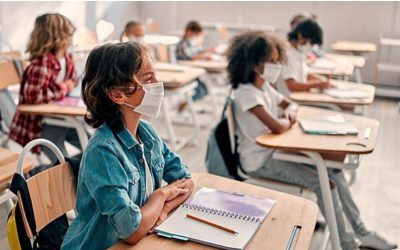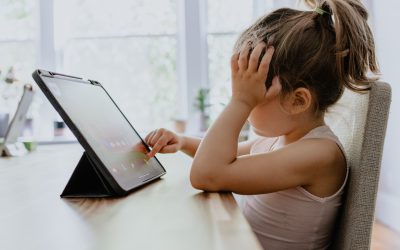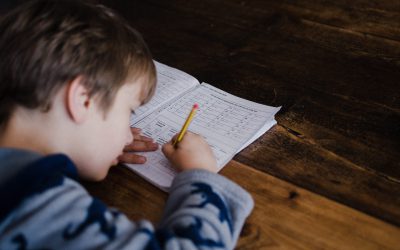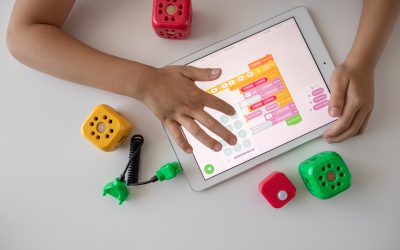Models for combining home education and school education
29 May 2020 | Professionals
As schools in the Netherlands have reopened to teach students in smaller groups, they have to combine in-school teaching and home-schooling. The guidelines of the Ministry of Education and the council for Primary Education ask schools to split classes in half and teach each group on full, alternating days where the school also offers worksheets or other types of activities/online instruction for the remaining 50% of home-schooling. Within these guidelines, schools can decide on the teaching schedule and how to organize in-school teaching and home-schooling.
Dr Agnes Willemen; Associate Professor Vrije Universiteit Amsterdam, The Netherlands; a.m.willemen@vu.nl
Prof. dr. Melanie Ehren; Professor Educational studies and director research institute LEARN!, Amsterdam, The Netherlands, m.c.m.ehren@vu.nl
Mariska Westdijk, director Education & Identity at CSG De Waard; m.westdijk@csgdewaard.nl
29-05-2020



Some of the models to combine home-schooling and in-school teaching are:
- Half of the students in a class is taught in school, when the other half is home-schooled that day. The groups alternate in-school teaching and home-schooling where home-schooling is structured according to one of the following three options:
- Students practice skills they have been taught the day before (in-school), using worksheets or other activities (either online or on paper), with (when possible) stand-by online support from teaching assistants or teachers with health risks.
- Choosing the principle of flipping the classroom, whereby students watch (online) instruction of new skills at home watch and practice new skills in school.
- Following the principles of inquiry-based learning where students work on their own small project, question or area of interest (in the form of, for example, writing a paper about a self-chosen subject);
- Half of the students receive instruction in-school, while the second half of the group attends the instruction at home via webcam, see for further explanation here.
Which option is chosen depends on the school’s teaching philosophy, their past experience with online learning and students’ access to, and ability to work remotely, including the type of platforms staff have learned to use and online materials they have developed over the past weeks (e.g. videos, working with an online platform, working with a webcam or tool such as Google Hangouts) as well as the extent to which teachers are able to come to school safely.
Schools who have teachers with potential health risks on staff can also choose a model where these teachers provide online instruction to students on their home-schooling day, or where students can dial-in to ask questions about the activities they are required to do at home.
We asked teachers and school leaders which of the models were implemented in their school, with an open answer option for other models. Even though these models will only be used for a brief period of time as schools will fully reopen on the 8th of June, an evaluation of the models allows us to learn for potential future (part) closure.
We received responses from 28 respondents (half of school leaders and half of teachers) from schools in Utrecht, Amsterdam, Hellendoorn, Purmerend and de Hoeksche Waard.
Schools choose 1a:
Home-schooling is practicing skills which have been taught in school the day before
Nearly 70% choose option 1a, with 11 % choosing option 1b and 11% schooling option 2.
None of the respondents mentioned option 1c; ‘inquiry-based learning’.
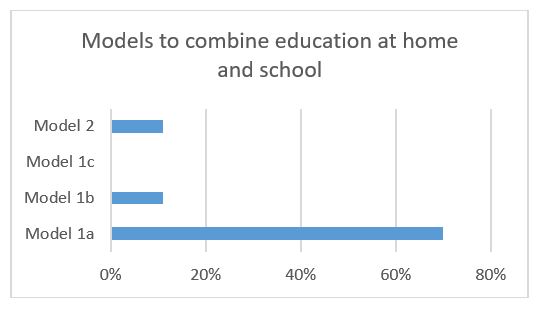
Figure 1. Schools choose option 1a
In the open-answer option (option 3), the following was noted:
“The teacher uses a week planning where some activities need to be done at school and some at home. All activities are accompanied by an instructional video in which the teacher provides supplementary explanation which pupils can watch at home and at school. ”
Effectiveness of models
How effective are these models for student learning? What can we learn from these models for the future, when schools may have to close again or when we need to use combined models for extra support or when (medically) vulnerable students and teachers cannot come to school?
To better understand the effect of these models on student learning outcomes, we need to consider two concepts in more detail. First home-schooling, second blended learning.
- Homeschooling
Research into homeschooling shows convincingly that the involvement of parents and carers in the education of their children contributes positively to the development of children[1]. Parental activities that were related to children’s learning outcomes were
- reading together,
- having positive expectations of children,
- trusting the teacher and the school, and
- having a supportive structure and environment in which children can do their schoolwork[2].
In the recent period of full-time home schooling, parents became mainly responsible for the success of homeschooling, and their involvement became more compulsory.
1.1 Support children’s autonomy with concrete didactic and pedagogical tips
Research into parental involvement in education has also focused on the quality or style of parental support. In this respect, an ‘autonomy-supporting style’, in which parents allow their children to do the schoolwork independently, choosing for example the order of their work and which subjects to take in the morning/afternoon is related to positive outcomes. A controlling way of support where the parent provides detailed instruction and controls follow-up can have negative rather than positive effects on the child as well as on the parent-child relationship[3]. Many parents therefore also need concrete tips from teachers, both didactic (how do I explain percentages?) as well as pedagogical (how can I motivate my child, build confidence, support their autonomy?) .
1.2 Variation in need for structure versus room for student creativity
When children are home schooled, it is important for them to be able do this on their own. A clear weekly schedule supports autonomy and independence. Learning resources that allow children to work independently are motivating. Teaching materials that match with their level are encouraging. It is helpful if instruction videos are online to enable children to watch these twice, and when the instruction is accompanied by a relevant set of activities. Some children like to follow the schedule and work on assignments exactly as prescribed, whereas other children are motivated when having some leeway in deciding on when to complete the work. Responsivity to these individual needs promotes children’s autonomy and involvement.
1.3 Importance of the parent-teacher relationship: educational partnership
In the current period of simultaneous education at home and school, teachers and parents are educational partners[4]. It is beneficial for the child, if teachers and parents collaborate and coordinate their support. A collaborative parent-teacher relationship, in which both participants want to learn from each other, contributes to the development of children. For some children, the period of home education has been fruitful; for example, pupils who get distracted in school when there are too many stimuli do well in a quieter environment and benefit from working with a parent on a one-to-one basis. It is important for parents to be acknowledged and accepted in their role, even when children are going back to school part-time.
The four possible models differ not only in how homeschooling and in-school teaching are combined, but also in the combination of online learning materials and face-to-face teaching; we call this blended learning.
- Blended learning
Initial studies on ‘blended learning’ were published around 2000, describing ‘blended learning’ as a well-thought out integration of online and face- to- face learning experiences[5]. Ideally, the integration results in a harmonious and hybrid learning entity, which is student-oriented, and is optimized by the combination of face- to -face interaction with ICT[6]. Blended learning is therefore more than simply combining education at home and at school.
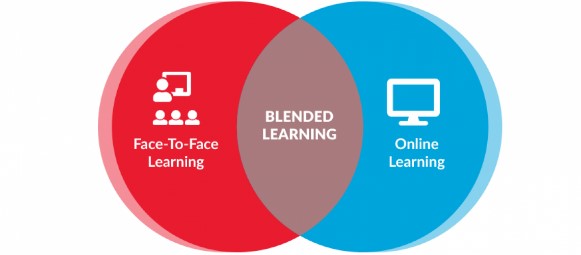
Figure 2. Blended learning, a harmonious entity of face- to- face and online learning
https://www.perview.nl/nl/ online -blended-learning /
2 .1 Online vs Face-to-face, synchronous vs asynchronous
Online education refers to all digital applications used in an educational learning environment. These can be digital tools to transfer knowledge (video, podcast, websites, knowledge clips), but also tools to meet each other (MSteams, Zoom), or tools that enable the learner to practice independently with learning materials (Emile, Mind up). Online education materials can be used by the student at home, school or elsewhere. Online education can be followed synchronously (at the same time) or asynchronously (at different times) by students. Face-to-face refers to all interactions at school or in another place where teachers and students are in each other’s physical presence.
2 .2 Learning experiences integrated into a harmonious entity
The strength of blended learning is not in having both parts separately, but rather in the integration of online and face-to-face learning experiences in a hybrid learning environment. A good integration of both types of teaching results in rich and diverse learning opportunities. It is interesting that in the literature on blended learning, the focus is on learning experiences and not on teaching materials. As a result, the focus is on students, and the learning experiences they experience.
2.3 Advantages and disadvantages of online and face- to -face teaching
Online and face-to face teaching have their own advantages – and disadvantages for students . These vary for the three common goals of education:
1) qualification, acquiring knowledge, skills and attitudes,
2) socialization, connecting with others and becoming part of existing practices,
3) subjectification, freedom and responsibility of the student[7].
Online education is flexible, adaptive and self-regulating
The great advantage of online education is that students can follow it at their own pace, their own place and their own moment in time. It is easy to watch the instruction several times, slow playback, or fast playback or skip some parts. When devices have to be shared with family members, it is helpful when children can determine the time point by themselves. As a result, the student experiences more autonomy in following education.
Online education can also be flexible in terms of differentiation in goals. Many online apps or software that are used in schools are adaptive, they start with exercises to determine the level and next challenges for students. Also, programs are self-regulating, they give feedback when a statement is not correct.
Online education can enrich the learning environment
Another benefit of online education is to offer a rich learning environment. The use of the internet offers many possibilities to connect learning more with society. A good example are the museums and zoos that developed a virtual tour for children. But other channels also offer material that can be used to enrich the learning environment of children in primary school and build their competence.
Online education makes it possible to monitor home education
A final advantage of online education is that education programs often enable teachers to monitor the progress of a student. The dashboard shows how many assignments students have made, which assignments they choose and do not choose, and which assignments were difficult. This gives teachers important information about the level and progress of the student, which they can connect to and challenge during school education.
Socialization and observation
Online education also has a major drawback, the physical distance. Many children experienced this distance with classmates and teachers during the last period. Although video calls were fun, it does not replace the play, interaction, and physical contact children of this age need so much. Contact with peers is important for the social-emotional development of children, self-confidence and self-image[8]. And playing with peers is crucial for young children to create meaningful learning experiences[9].
Face-to-face education at school therefore has an important meaning for the core objective of socialization. A second advantage of face-to-face education in the classroom is that teachers can observe how a child behaves. Is the instruction understood, is the student able to start work, what does the student feel or think? This offers many opportunities to directly intervene, which is not possible when being online. The PO Council (the Dutch council of primary schools) therefore advises teachers to use the time in school to support the social and emotional development of children.
Summarizing
In summary, we can say that online education has a number of advantages (flexible, rich learning environment, adaptive and self-regulating ), but that education in school has an important social function. Furthermore, education at school enables teachers to observe and support the cognitive and social-emotional development of children. The combination of online and face-to-face education at home and at school therefore offers many opportunities, particularly when offered in an integrated manner with the individual pupil’s learning trajectory at the centre of the teaching and learning.
- Effectiveness of the different models
Considering the requirements of home schooling and the benefits and disadvantages of online education, we can assess the different models (Table 1) .
We assess these models mainly on the basis of educational outcomes (learning performance and development of students’ social competences). However, other considerations also play a role when deciding on which model to choose, such as preventing the spread of the virus and economic interests ( for example, the role of schools in enabling parents to work full-time).
Option 1a
With option 1, one group follows education in the school and the other group works independently at home using a daily and weekly schedule. In the most common combination (1a) children follow instructions in school and do exercises and assignments (electronic and paper) at home. The advantage of this approach for teachers is that they can focus on what is happening in the classroom. If there is good instruction, practice, processing and feedback at school, students can continue independently at home. Teachers no longer have to provide guidance in home education. In this way, teachers are able to guide two groups following asynchronous education. This model has the advantage that the learning experiences at home and at school are integrated. Another benefit for students is that they can ask the teacher questions about the instruction, learn from questions from other children, and receive additional explanations when needed.
The disadvantage of this model for students is that the instruction is no longer online, and children (and parents) are not able to view the instruction at home. This can be troublesome for parents to help their children with the assignments. Another drawback is that the precious time at school – which should primarily have a social function – is now used for instruction. Dependent of the instruction methods being used, instruction could be a one-way process and offers less opportunity for social activity. A third drawback is that when students make assignments at home, teachers are not able to see how they are doing and whether extra instruction is needed. This may result in a loss of motivation and commitment.
Here is an opportunity for online learning material. When the learning activities can be carried out digitally at home, and the program provides feedback and tracks progress, some of these disadvantages can be properly overcome.
Option 1b
Option 1b is exactly the opposite, and children follow the instruction at home and do assignments to practice skills or revise their work at school (flipping the classroom). So here the pros and cons are reversed. In this model, teachers are able to observe whether the instruction has been understood and what their potential misconceptions are when working on assignments. Teachers can offer additional instruction in different ways to the children who need it. In addition, children (and parents) have the opportunity to watch the instruction as often as they want, or skip it if they already understand it. In this model, parents become less responsible for the understanding and application of knowledge, a relief for many parents who do not have the time or opportunities for homeschooling. In this model, time at school can be used to promote learning, working and playing together.
A disadvantage can be that pupils’ have forgotten part of the instruction from the previous day, and are unable to apply it when working on activities and assignments in school. But this can be overcome when teachers take time to further explain and activate. The advantages of this model are supported in research which shows the positive effects of flipping the classroom on learning outcomes and commitment[10], although most research has been carried out in secondary and higher education.
Option 1c
In option 1c, pupils work on a project using the method of inquiry based learning, such as where pupils work on their research project at home and at school. Other schools sometimes opt for pupils working at home on a project in one of the non-core subjects (art and design, geography, history), while school time is used for the core subjects of literacy and numeracy.
Depending on which models is used, a disadvantage may be that the learning experiences at home and at school are not well integrated. A second drawback may be that the supervision of the project at home lies entirely with the parents.
For inquiry-based learning to succeed, projects also need to allow pupils to decide a topic of their own interest, while also having a clear structure (the steps to be taken) for both pupil and parents. It seems also important that the use of online learning materials is promoted, and that the project offers opportunities for connection with others (collaboration) at school. When the project also serves important learning goals, and a certain level is expected, good monitoring and feedback from the teacher is important.
Option 2
With option 2, children at home and at school receive instruction simultaneously, one group at school and the other group at home via a webcam. This option has the advantage of not splitting the class in two, allowing all pupils to ‘see’ each other every day. Teachers also have the advantage of being to work synchronously with all pupils and not having to split their time; offering additional instruction for those who need is easier in this model.
A challenge is however to involve students at home and in school at the same time. In addition, playing and working together in this model is still limited. A disadvantage of a webcam is also that the teacher cannot see the children at home, or the children cannot see each other, although some schools have developed very advanced options for this.
For students, live instruction in the school has some disadvantaged compared to an online option in terms of the lack of flexibility and adaptability. When students have to start working independently after the instruction, they can no longer ask the teacher for help, and they cannot view the instruction again. This disadvantage also applies to parents. Depending on which online tools are used for independent work, the effect of this model can be more or less positive.
Option 3 (open answer option)
The teacher who described option 3 uses a weekly planner with an overview of lessons and activities for each day of the week. All lessons include an instructional video, allowing students to watch the instruction both at home and at school. The difference with model 1b is that the student can continue with activities and assignments immediately after watching the instruction, ensuring a coherent learning experience. In this model, the instruction is completely asynchronous and the instruction film is used optimally, enabling both teachers and pupils to use their time effectively and efficiently. This model is perhaps the most student-oriented, but it asks the most investment in time of the teacher and of availability of online resources.
The below table summarizes the pros and cons of the various models:
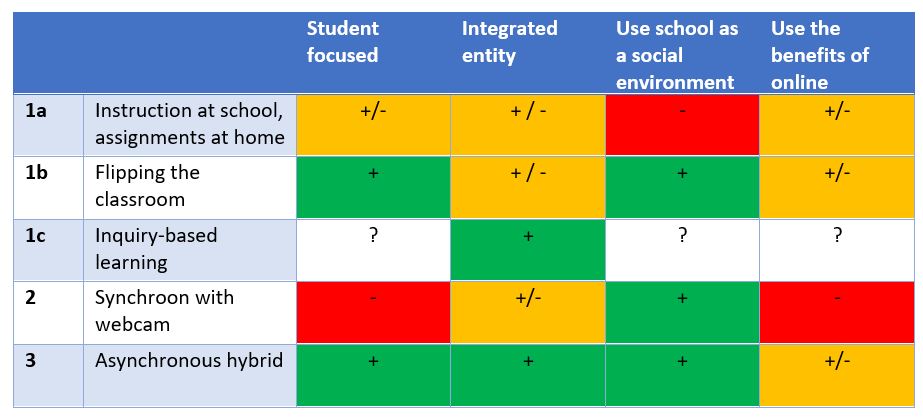
Table 1. advantages and disadvantages of the different models
Conclusion
Based on this analyses, we conclude that model 3 appears to be the most effective. In this model, the benefits of online education are used as much as possible, there is a lot of flexibility for the student, and education at home, at school and online are integrated in a coherent entity. Model 1b (flipping the classroom) is a close second, especially when the instructional videos can also be viewed in the classroom. Unfortunately, these models are the most time-intensive for teachers.
Although model 1a is most commonly used by the schools that responded to the poll, this model appears to be less effective: time for instruction is at the expense of time for social activities, while there is also little time for checking pupils’ understanding of the instruction and for further explanation. Specific learning outcomes will however depend on the exact amount of time for each of the activities; something we didn’t ask in our poll.
Finally, the use of online learning resources can further increase the effectiveness of the models. Blended learning offers many opportunities to tailor education to the needs of students, especially when online resources and instruction are integrated with the face-to-face teaching in school and are student-oriented. Digital tools that provide a rich learning environment and support good teacher monitoring can be used very well in this period of home education . A comprehensive overview of online learning resources can be found here.
[1] Bakker, J. T. A., Denessen, E. J. P. G., Dennissen, M. H. J., & Oolbekkink-Marchand, H. W. (2013). Leraren en ouderbetrokkenheid: Een reviewstudie naar de effectiviteit van ouderbetrokkenheid en de rol die leraren daarbij kunnen vervullen. Nijmegen, Radboud Universiteit. https://hdl.handle.net/2066/121840
[2] Boonk, L., Gijselaers, H.J.M., Ritzen, H., Brand-Gruwel, S. (2018) A review of the relationship between parental involvement indicators and academic achievement. Educational Research Review, 24, 10-30. https://doi.org/10.1016/j.edurev.2018.02.001.
[3] Bailey, L. B. (2006). Interactive homework: A tool for fostering parent–child interactions and improving learning outcomes for at-risk young children. Early Childhood Education Journal, 34(2), 155. https://doi.org/10.1007/s10643-006-0114-y
[4] Iliás, M., Willemen, A., Dobber, M., Pels, T., Oosterman, M., & Schuengel, C. (2016). Een schoolleergemeenschap met leerkrachten en ouders. Pedagogiek, 36(3), 307-337. https://doi.org/10.5117/PED2016.3.ILIA
[5] Garrison, D.R., & Kanuka, H. (2004). Blended learning: Uncovering its transformative potential in higher education. Internet and Higher Education, 7(2), 95-105. https://doi.org/10.1016/j.iheduc.2004.02.001
[6] Güzer, B., & Caner, H. (2014). The past, present and future of blended learning: an in depth analysis of literature. Procedia-Social and Behavioral Sciences, 116, 4596-4603 https://doi.org/10.1016/j.sbspro.2014.01.992
[7] Biesta, G., & Pols, W. (2012). Goed onderwijs en de cultuur van het meten. Amsterdam: Boom Lemma.
[8] Blum, R. W., Libbey, H. P., Bishop, J. H., & Bishop, M. (2004). School connectedness—Strengthening health and education outcomes for teenagers. Journal of School Health, 74(7), 231-235. https://doi.org/10.1111/j.1746-1561.2004.tb08278.x
[9] van Oers, B. (2003). Learning resources in the context of play: Promoting effective learning in early childhood. European Early Childhood Education Research Journal, 11(1), 7- 26. https://doi.org/10.1080/13502930385209031
[10] van Alten, D. C., Phielix, C., Janssen, J., & Kester, L. (2019). Effects of flipping the classroom on learning outcomes and satisfaction: A meta-analysis. Educational Research Review. doi:10.1016/j.edurev.2019.05.003
See also information for:
Most recent blogs:
How LEARN! supports primary and secondary schools in mapping social-emotional functioning and well-being for the school scan of the National Education Program
Jun 28, 2021
Extra support, catch-up programmes, learning delays, these have now become common terms in...
Conference ‘Increasing educational opportunities in the wake of Covid-19’
Jun 21, 2021
Covid-19 has an enormous impact on education. This has led to an increased interest in how recent...
Educational opportunities in the wake of COVID-19: webinars now available on Youtube
Jun 17, 2021
On the 9th of June LEARN! and Educationlab organized an online conference about...
Homeschooling during the COVID-19 pandemic: Parental experiences, risk and resilience
Apr 1, 2021
Lockdown measures and school closures due to the COVID-19 pandemic meant that families with...
Catch-up and support programmes in primary and secondary education
Mar 1, 2021
The Ministry of Education, Culture and Science (OCW) provides funding in three application rounds...
Home education with adaptive practice software: gains instead of losses?
Jan 26, 2021
As schools all over Europe remain shuttered for the second time this winter because of the Covid...


